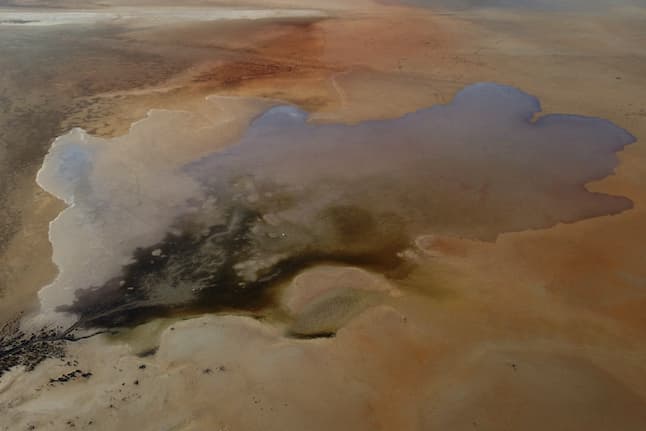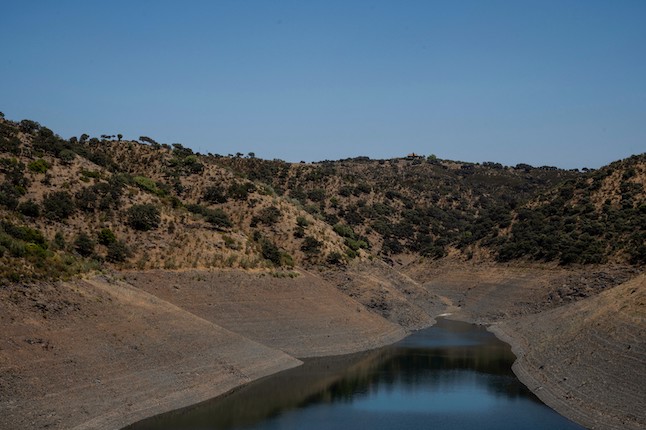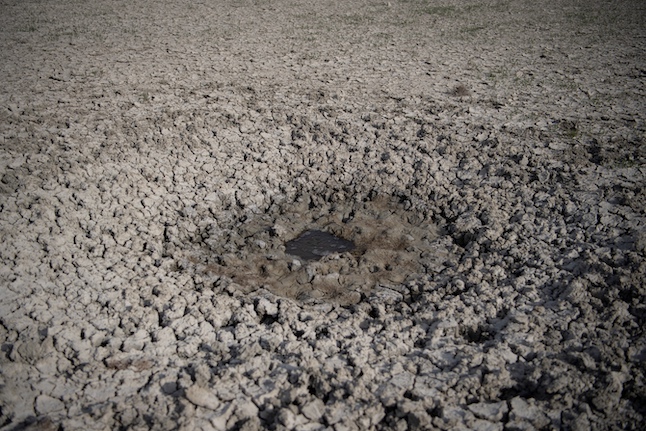IN PICTURES: Drought in Spain intensifies as Roman fort uncovered

Spain is on its way to experiencing one of the worst droughts since records began with reservoirs at their lowest levels in more than a decade. These pictures tell the story.
Many regions across Spain are already suffering from a lack of water and reserves have fallen to 39 percent, the lowest percentage since 1995.
However, a further study published by the Nature Geoscience journal claims that climate change has left parts of the Iberian peninsula at their driest in 1,200 years.
There are already limits on water usage in some municipalities in Catalonia, Galicia, Andalusia, Extremadura, Castilla y León and Castilla-La Mancha.
READ ALSO - Drought: Where in Spain are there limits on water usage?
A prolonged dry spell and extreme heatwaves caused July to be the hottest month on record in Spain, since at least 1961.
#RomanfortThursday In 1948 the dam waters completely covered the site of “A Cidá”(#AquisQuerquennis) as well as much of the ancient #ViaNova, a #Romanroad that linked Braga and Astorga. Photo (Right): Inauguration of the dam by Francisco Franco in 1949 (@RomanArmy_eu) pic.twitter.com/uCwA8fnt6s
— Aquis 3D (@Aquis3D) August 11, 2022
Water levels in the Limia River in Galicia are so low that the remains of the ancient Roman fort of Aquis Querquennis have been revealed. They were flooded during the Franco era in 1949 when the As Conchas dam and reservoir were built. The fortress was built around 69-79 AD and was once home to Roman legions when they built the Via Nova road. The site was finally abandoned in 120 AD.
A severe drought has left the Cijara reservoir in Spain more than 80% empty. Spanish Energy Minister Teresa Ribera said the drought was also causing wildfires https://t.co/S3zsZwOqve pic.twitter.com/zrRTkv9pL6
— Reuters (@Reuters) August 11, 2022
The Cijara reservoir in Extremadura is now 84 percent empty after severe drought and animals are having to survive on what little water remains.

El Rumblar dam near Baños de la Encina. Photo: PIERRE-PHILIPPE MARCOU / AFP
Located in the Jaén province in Andalusia, the El Rumblar dam near Baños de la Encina is experiencing some of its lowest levels. Jaén used to get around 800 litres (210 gallons) of rainfall per square metre, but is set to only get around half that amount this year.

There is hardly anything left of this waterhole in Andalusia. Photo: JORGE GUERRERO / AFP
This used to be a waterhole in the Doñana National Park, located in the drought-prone province of Huelva. The huge park, home to one of Europe's largest wetlands, is threatened by intensive farming. Water supplies to the park have declined dramatically due to climate change and the over-extraction of water by neighbouring strawberry farms, often through illegal wells, scientists say.
https://twitter.com/slot92015754/status/1557721325418037248
The reservoirs at the mouth of the River Tagus - Entrepeñas and Buendía in Castilla-La Mancha have lost 23.53 cubic hectometres this week and currently store a total of 566.14 cubic hectometres, which represents 22.5 percent of their capacity, according to data provided by the Tagus Hydrographic Confederation.
https://twitter.com/EFEnoticias/status/1557707029950746625
In Navarra, the Yesa Reservoir has entered an emergency situation as only 183 cubic hectometres of water are left. The last time these levels were recorded was during the 2001-2002 drought.
Comments
See Also
Many regions across Spain are already suffering from a lack of water and reserves have fallen to 39 percent, the lowest percentage since 1995.
However, a further study published by the Nature Geoscience journal claims that climate change has left parts of the Iberian peninsula at their driest in 1,200 years.
There are already limits on water usage in some municipalities in Catalonia, Galicia, Andalusia, Extremadura, Castilla y León and Castilla-La Mancha.
READ ALSO - Drought: Where in Spain are there limits on water usage?
A prolonged dry spell and extreme heatwaves caused July to be the hottest month on record in Spain, since at least 1961.
#RomanfortThursday In 1948 the dam waters completely covered the site of “A Cidá”(#AquisQuerquennis) as well as much of the ancient #ViaNova, a #Romanroad that linked Braga and Astorga. Photo (Right): Inauguration of the dam by Francisco Franco in 1949 (@RomanArmy_eu) pic.twitter.com/uCwA8fnt6s
— Aquis 3D (@Aquis3D) August 11, 2022
Water levels in the Limia River in Galicia are so low that the remains of the ancient Roman fort of Aquis Querquennis have been revealed. They were flooded during the Franco era in 1949 when the As Conchas dam and reservoir were built. The fortress was built around 69-79 AD and was once home to Roman legions when they built the Via Nova road. The site was finally abandoned in 120 AD.
A severe drought has left the Cijara reservoir in Spain more than 80% empty. Spanish Energy Minister Teresa Ribera said the drought was also causing wildfires https://t.co/S3zsZwOqve pic.twitter.com/zrRTkv9pL6
— Reuters (@Reuters) August 11, 2022
The Cijara reservoir in Extremadura is now 84 percent empty after severe drought and animals are having to survive on what little water remains.

Located in the Jaén province in Andalusia, the El Rumblar dam near Baños de la Encina is experiencing some of its lowest levels. Jaén used to get around 800 litres (210 gallons) of rainfall per square metre, but is set to only get around half that amount this year.

This used to be a waterhole in the Doñana National Park, located in the drought-prone province of Huelva. The huge park, home to one of Europe's largest wetlands, is threatened by intensive farming. Water supplies to the park have declined dramatically due to climate change and the over-extraction of water by neighbouring strawberry farms, often through illegal wells, scientists say.
https://twitter.com/slot92015754/status/1557721325418037248
The reservoirs at the mouth of the River Tagus - Entrepeñas and Buendía in Castilla-La Mancha have lost 23.53 cubic hectometres this week and currently store a total of 566.14 cubic hectometres, which represents 22.5 percent of their capacity, according to data provided by the Tagus Hydrographic Confederation.
https://twitter.com/EFEnoticias/status/1557707029950746625
In Navarra, the Yesa Reservoir has entered an emergency situation as only 183 cubic hectometres of water are left. The last time these levels were recorded was during the 2001-2002 drought.
Join the conversation in our comments section below. Share your own views and experience and if you have a question or suggestion for our journalists then email us at [email protected].
Please keep comments civil, constructive and on topic – and make sure to read our terms of use before getting involved.
Please log in here to leave a comment.